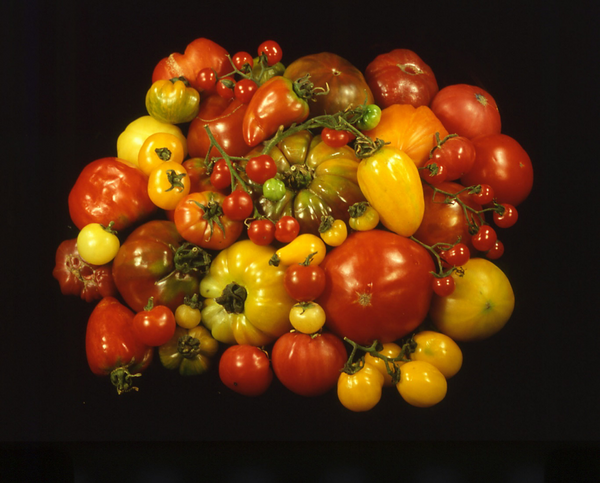JXB Volume 73, Issue 11 – Editor’s choice
This article highlights the following publication:
European traditional tomatoes galore: a result of farmers’ selection of a few diversity-rich loci
Jose Blanca, Clara Pons, Javier Montero-Pau, David Sanchez-Matarredona, Peio Ziarsolo, Lilian Fontanet, Josef Fisher, Mariola Plazas, Joan Casals, Jose Luis Rambla, Alessandro Riccini, Samuela Pombarella, Alessandra Ruggiero, Maria Sulli, Stephania Grillo, Angelos Kanellis, Giovanni Giuliano, Richard Finkers, Maria Cammareri, Silvana Grandillo, Andrea Mazzucato, Mathilde Causse, Maria José Díez, Jaime Prohens, Dani Zamir, Joaquin Cañizares, Antonio Jose Monforte, Antonio Granell
Journal of Experimental Botany, Volume 73, Issue 11, 2 June 2022, Pages 3431–3445, https://doi.org/10.1093/jxb/erac072

A display of the European tomato fruit diversity showing fruits of different sizes, shapes and colours collected from different regions of Europe.
How the golden apple conquered Europe: New insights into the history of tomato diversification
Tomatoes are without doubt the epitome of Italian food. ‘Il pomodoro’, the ‘golden apple’, is a key ingredient of many typical dishes such as Pizza Margherita or Caprese salad, in which red tomatoes, white mozzarella, and green basil represent the colours of the Italian national flag. Tomatoes are also central to the traditional cuisine of many other European countries. The chilled tomato soup Gazpacho is a culinary classic from Spain and white beans stewed in tomato sauce are essential to every English full breakfast. They are loved for their heavenly taste also in Austria and consequently called ‘paradeiser’, the ‘apple of paradise’.
However, tomatoes are not indigenous plants in Europe but were introduced by Spanish conquistadors in the early 16th century upon their return from Mesoamerica where the tomato was domesticated by the Aztecs. The ancestor of the worldwide cultivated form Solanum lycopersicum L. var. lycopersicum is Solanum lycopersicum L. var. cerasiforme, whose wild relative Solanum pimpinellifolium is native to Peru and Ecuador.
Europeans were sceptical about this foreign fruit at first as it was considered poisonous due to its resemblance to the toxic deadly nightshade. Tomatoes were thus only grown as ornamental plants with the fruits being used as tabletop decoration, but they eventually found their way into people’s kitchens and hearts first in the Mediterranean countries and by the 19th century also in the rest of Europe.
Nowadays, tomatoes are among the most popular vegetables worldwide. Modern varieties have been bred mainly for size and production-related traits such as pest resistance, even ripening, and long shelf life to allow for long-term storage and long-distance transport. This has led to a significant reduction in genetic diversity among modern accessions, and consumers oftentimes complain about watery and tasteless supermarket tomatoes devoid of intense flavours. In parallel to commercial breeding by seed companies, many farmers especially in Southern Europe have developed their own traditional varieties that are adapted to local preferences regarding taste and fruit morphology. Hundreds of years of on-farm evolution have yielded a plethora of different tomato types that are still much appreciated and cultivated for fresh or processed consumption. Conserving the gene pool of these traditional tomatoes is of high importance for the further development of new varieties with superior traits.
For this a profound understanding of the genetic diversity is essential, which has led a multinational group of researchers from ten different institutions to analyse the genetic make-up and associated phenotypes of traditional European tomatoes. The results have been published in issue 11 of the Journal of Experimental Botany (Blanca et al., 2022), and they shed light on the history of tomato diversification in Europe since their first arrival on the continent 500 years ago.
The authors collected 1,254 tomato varieties from South European seed banks and other seed collections comprising hundreds of traditional accessions as well as several modern cultivars and wild tomato ancestors and relatives. They were genetically characterised using genotyping by sequencing (GBS), an efficient high-throughput method to identify genetic variants. The genetic data was statistically analysed to identify and visualize similarities between the different varieties. As expected, distinct clusters of the wild forms from Mesoamerica and South America were found that were clearly separated from the European tomatoes which indicates their genetic distancing that occurred during domestication.
The modern and traditional varieties, however, did not show clearly separated groups, but a continuous genetic gradient was revealed. It is likely that introgression of genetic material from modern haplotypes into the gene pool of traditional varieties occurred unintentionally, for example when farmers used both their own seeds from tomato landraces alongside material from professional breeders. Clear differentiation between modern and vintage races can be challenging and the authors found that according to the genetic data reclassification of several varieties was necessary since they had mistakenly been labelled as traditional. The authors also found a genetic gradient within the traditional European tomatoes with Italian and Spanish varieties defining two different genetic clusters. Thus, genetic mixing between these two major regions of tomato cultivation must have occurred. Remarkably, the traditional varieties showed a significantly reduced genetic diversity compared to their wild ancestors and the modern varieties.
These findings are surprising given the vast morphological diversity found among traditional tomatoes that differ substantially in size, colour, shape, and other agronomic traits. A more detailed analysis of the genetic material showed that only few polymorphic genes underly the large phenotypic variation. Based on their comprehensive genome analysis the authors conclude that Spain and Italy form two centres of secondary diversification of tomatoes. In both countries farmers started cultivating plants with very limited gene pools and gradually developed new varieties by combining a relatively low number of genes. This form of balancing selection over hundreds of years has yielded the multitude of different phenotypes nowadays present in the traditional European tomato collection.
This newly gained understanding of the genetic and morphological structure can be used to conserve the precious genetic material of traditional accessions and to create new varieties in the future to meet different consumer preferences.
